17.3: Speed of Sound
( \newcommand{\kernel}{\mathrm{null}\,}\)
- Explain the relationship between wavelength and frequency of sound
- Determine the speed of sound in different media
- Derive the equation for the speed of sound in air
- Determine the speed of sound in air for a given temperature
Sound, like all waves, travels at a certain speed and has the properties of frequency and wavelength. You can observe direct evidence of the speed of sound while watching a fireworks display (Figure 17.3.1). You see the flash of an explosion well before you hear its sound and possibly feel the pressure wave, implying both that sound travels at a finite speed and that it is much slower than light.

The difference between the speed of light and the speed of sound can also be experienced during an electrical storm. The flash of lighting is often seen before the clap of thunder. You may have heard that if you count the number of seconds between the flash and the sound, you can estimate the distance to the source. Every five seconds converts to about one mile. The velocity of any wave is related to its frequency and wavelength by
v=fλ,
where v is the speed of the wave, f is its frequency, and λ is its wavelength. Recall from Waves that the wavelength is the length of the wave as measured between sequential identical points. For example, for a surface water wave or sinusoidal wave on a string, the wavelength can be measured between any two convenient sequential points with the same height and slope, such as between two sequential crests or two sequential troughs. Similarly, the wavelength of a sound wave is the distance between sequential identical parts of a wave—for example, between sequential compressions (Figure 17.3.2). The frequency is the same as that of the source and is the number of waves that pass a point per unit time.
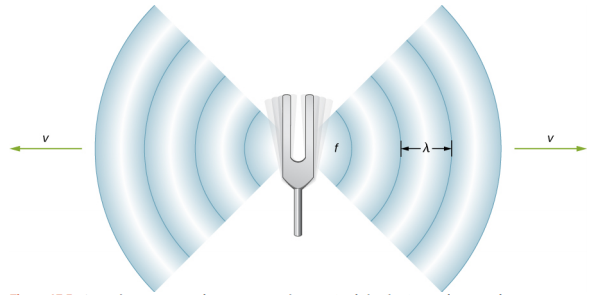
Speed of Sound in Various Media
Table 17.3.1 shows that the speed of sound varies greatly in different media. The speed of sound in a medium depends on how quickly vibrational energy can be transferred through the medium. For this reason, the derivation of the speed of sound in a medium depends on the medium and on the state of the medium. In general, the equation for the speed of a mechanical wave in a medium depends on the square root of the restoring force, or the elastic property, divided by the inertial property,
v=√elastic propertyinertial property.
Also, sound waves satisfy the wave equation derived in Waves,
∂2y(x,t)∂x2=1v2∂2y(x,t)∂t2.
Recall from Waves that the speed of a wave on a string is equal to v=√FTμ, where the restoring force is the tension in the string FT and the linear density μ is the inertial property. In a fluid, the speed of sound depends on the bulk modulus and the density,
v=√Bρ.
The speed of sound in a solid the depends on the Young’s modulus of the medium and the density,
v=√Yρ.
In an ideal gas (see The Kinetic Theory of Gases), the equation for the speed of sound is
v=√γRTKM,
where γ is the adiabatic index, R = 8.31 J/mol • K is the gas constant, TK is the absolute temperature in kelvins, and M is the molecular mass. In general, the more rigid (or less compressible) the medium, the faster the speed of sound. This observation is analogous to the fact that the frequency of simple harmonic motion is directly proportional to the stiffness of the oscillating object as measured by k, the spring constant. The greater the density of a medium, the slower the speed of sound. This observation is analogous to the fact that the frequency of a simple harmonic motion is inversely proportional to m, the mass of the oscillating object. The speed of sound in air is low, because air is easily compressible. Because liquids and solids are relatively rigid and very difficult to compress, the speed of sound in such media is generally greater than in gases.
Because the speed of sound depends on the density of the material, and the density depends on the temperature, there is a relationship between the temperature in a given medium and the speed of sound in the medium. For air at sea level, the speed of sound is given by
v=331m/s√1+TC273°C=331m/s√TK273K
where the temperature in the first equation (denoted as TC) is in degrees Celsius and the temperature in the second equation (denoted as TK) is in kelvins. The speed of sound in gases is related to the average speed of particles in the gas,
vrms=√3kBTm.
where kB is the Boltzmann constant (1.38 x 10−23 J/K) and m is the mass of each (identical) particle in the gas. Note that v refers to the speed of the coherent propagation of a disturbance (the wave), whereas vrms describes the speeds of particles in random directions. Thus, it is reasonable that the speed of sound in air and other gases should depend on the square root of temperature. While not negligible, this is not a strong dependence. At 0°C , the speed of sound is 331 m/s, whereas at 20.0 °C, it is 343 m/s, less than a 4% increase. Figure 17.3.3 shows how a bat uses the speed of sound to sense distances.
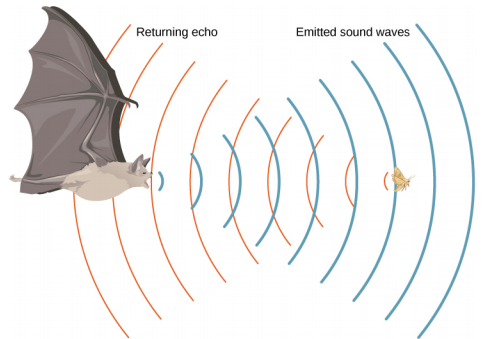
Derivation of the Speed of Sound in Air
As stated earlier, the speed of sound in a medium depends on the medium and the state of the medium. The derivation of the equation for the speed of sound in air starts with the mass flow rate and continuity equation discussed in Fluid Mechanics. Consider fluid flow through a pipe with cross-sectional area A (Figure 17.3.4). The mass in a small volume of length x of the pipe is equal to the density times the volume, or
m=ρV=ρAx.
The mass flow rate is
dmdt=ddt(ρV)=ddt(ρAx)=ρAdxdt=ρAv.
The continuity equation from Fluid Mechanics states that the mass flow rate into a volume has to equal the mass flow rate out of the volume,
ρinAinvin=ρoutAoutvout.
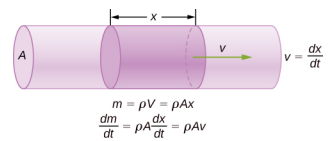
Now consider a sound wave moving through a parcel of air. A parcel of air is a small volume of air with imaginary boundaries (Figure 17.3.5). The density, temperature, and velocity on one side of the volume of the fluid are given as ρ, T, v, and on the other side are ρ + dρ, T+dT, v+dv.
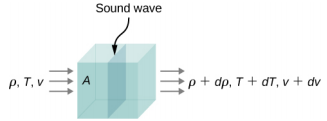
The continuity equation states that the mass flow rate entering the volume is equal to the mass flow rate leaving the volume, so
ρAv=(ρ+dρ)A(v+dv).
This equation can be simplified, noting that the area cancels and considering that the multiplication of two infinitesimals is approximately equal to zero: dρ(dv) ≈ 0,
ρv=(ρ+dρ)(v+dv)=ρv+ρ(dv)+(dρ)v+(dρ)(dv)0=ρ(dv)+(dρ)vρdv=−vdρ.
The net force on the volume of fluid (Figure 17.3.6) equals the sum of the forces on the left face and the right face:
Fnet=pdydz−(p+dp)dydz =pdydz−pdydz−dpdydz=−dpdydzma=−dpdydz.
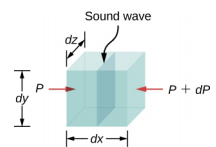
Figure 17.3.6:
The acceleration is the force divided by the mass and the mass is equal to the density times the volume, m = ρV = ρ dx dy dz. We have
ma=−dpdydza=−dpdydzm=−dpdydzρdxdydz=−dpρdxdvdt=−dpρdxdv=−dpρdxdt=−dpρ1vρvdv=−dp.
From the continuity equation ρ dv = −vdρ, we obtain
ρvdv=−dp(−vdρ)v=−dpv=√dpdρ.
Consider a sound wave moving through air. During the process of compression and expansion of the gas, no heat is added or removed from the system. A process where heat is not added or removed from the system is known as an adiabatic system. Adiabatic processes are covered in detail in The First Law of Thermodynamics, but for now it is sufficient to say that for an adiabatic process, pVγ=constant, where p is the pressure, V is the volume, and gamma (γ) is a constant that depends on the gas. For air, γ = 1.40. The density equals the number of moles times the molar mass divided by the volume, so the volume is equal to V = nMρ. The number of moles and the molar mass are constant and can be absorbed into the constant p (1ρ)γ = constant. Taking the natural logarithm of both sides yields ln p − γ ln ρ = constant. Differentiating with respect to the density, the equation becomes
lnp−γlnρ=constantddρ(lnp−γlnρ)=ddρ(constant)1pdpdρ−γρ=0dpdρ=γpρ.
If the air can be considered an ideal gas, we can use the ideal gas law:
pV=nRT=mMRTp=mVRTM=ρRTM.
Here M is the molar mass of air:
dpdρ=γpρ=γ(ρRTM)ρ=γRTM.
Since the speed of sound is equal to v = √dpdρ, the speed is equal to
v=√γRTM.
Note that the velocity is faster at higher temperatures and slower for heavier gases. For air, γ = 1.4, M = 0.02897 kg/mol, and R = 8.31 J/mol • K. If the temperature is TC = 20 °C (T = 293 K), the speed of sound is v = 343 m/s. The equation for the speed of sound in air v = √γRTM can be simplified to give the equation for the speed of sound in air as a function of absolute temperature:
v=√γRTM=√γRTM(273K273K)=√(273K)γRM√T273K≈331m/s√T273K.
One of the more important properties of sound is that its speed is nearly independent of the frequency. This independence is certainly true in open air for sounds in the audible range. If this independence were not true, you would certainly notice it for music played by a marching band in a football stadium, for example. Suppose that high-frequency sounds traveled faster—then the farther you were from the band, the more the sound from the low-pitch instruments would lag that from the high-pitch ones. But the music from all instruments arrives in cadence independent of distance, so all frequencies must travel at nearly the same speed. Recall that
v=fλ.
In a given medium under fixed conditions, v is constant, so there is a relationship between f and λ; the higher the frequency, the smaller the wavelength (Figure 17.3.7).
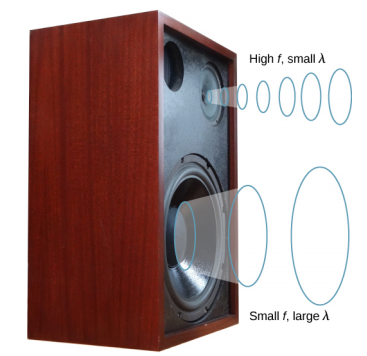
Calculate the wavelengths of sounds at the extremes of the audible range, 20 and 20,000 Hz, in 30.0 °C air. (Assume that the frequency values are accurate to two significant figures.)
Strategy
To find wavelength from frequency, we can use v=fλ.
Solution
- Identify knowns. The value for v is given by v=331m/s√T273K.
- Convert the temperature into kelvins and then enter the temperature into the equation v=331m/s√303K273K=348.7m/s.
- Solve the relationship between speed and wavelength for λ: λ=vf.
- Enter the speed and the minimum frequency to give the maximum wavelength: λmax=348.7m/s20Hz=17m.
- Enter the speed and the maximum frequency to give the minimum wavelength: λmin=348.7m/s20,000Hz=0.017m=1.7cm.
Significance
Because the product of f multiplied by λ equals a constant, the smaller f is, the larger λ must be, and vice versa.
The speed of sound can change when sound travels from one medium to another, but the frequency usually remains the same. This is similar to the frequency of a wave on a string being equal to the frequency of the force oscillating the string. If v changes and f remains the same, then the wavelength λ must change. That is, because v=fλ, the higher the speed of a sound, the greater its wavelength for a given frequency.
Imagine you observe two firework shells explode. You hear the explosion of one as soon as you see it. However, you see the other shell for several milliseconds before you hear the explosion. Explain why this is so.
Although sound waves in a fluid are longitudinal, sound waves in a solid travel both as longitudinal waves and transverse waves. Seismic waves, which are essentially sound waves in Earth’s crust produced by earthquakes, are an interesting example of how the speed of sound depends on the rigidity of the medium. Earthquakes produce both longitudinal and transverse waves, and these travel at different speeds. The bulk modulus of granite is greater than its shear modulus. For that reason, the speed of longitudinal or pressure waves (P-waves) in earthquakes in granite is significantly higher than the speed of transverse or shear waves (S-waves). Both types of earthquake waves travel slower in less rigid material, such as sediments. P-waves have speeds of 4 to 7 km/s, and S-waves range in speed from 2 to 5 km/s, both being faster in more rigid material. The P-wave gets progressively farther ahead of the S-wave as they travel through Earth’s crust. The time between the P- and S-waves is routinely used to determine the distance to their source, the epicenter of the earthquake. Because S-waves do not pass through the liquid core, two shadow regions are produced (Figure 17.3.8).
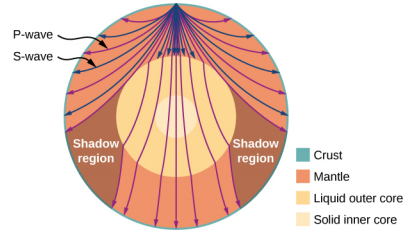
As sound waves move away from a speaker, or away from the epicenter of an earthquake, their power per unit area decreases. This is why the sound is very loud near a speaker and becomes less loud as you move away from the speaker. This also explains why there can be an extreme amount of damage at the epicenter of an earthquake but only tremors are felt in areas far from the epicenter. The power per unit area is known as the intensity, and in the next section, we will discuss how the intensity depends on the distance from the source.


